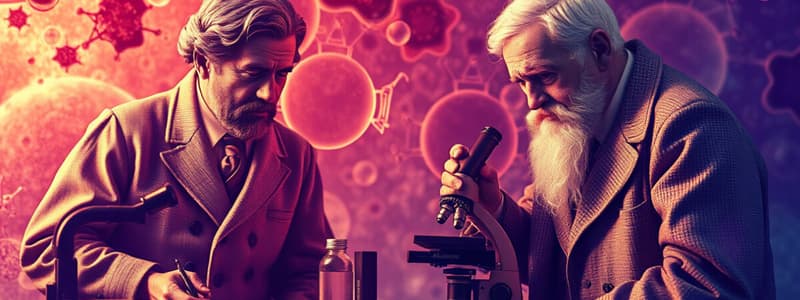Podcast
Questions and Answers
What is the main function of peroxisomes in a cell?
What is the main function of peroxisomes in a cell?
- Production of ATP from glucose
- Facilitation of passive transport across cell membranes
- Involvement in oxidation reactions and breaking down metabolic hydrogen peroxide (correct)
- Synthesis of fatty acids from glycerol
During glycolysis, which of the following is NOT produced?
During glycolysis, which of the following is NOT produced?
- 2 ATP
- 2 molecules of pyruvate
- 2 molecules of Acetyl CoA (correct)
- 2 NADH
What drives active transport in cellular processes?
What drives active transport in cellular processes?
- Hydrogen ion gradients
- Concentration gradients
- Facilitated diffusion proteins
- Energy derived from ATP (correct)
What happens during chemiosmosis?
What happens during chemiosmosis?
Which statement about the Kreb Cycle is accurate?
Which statement about the Kreb Cycle is accurate?
Who was the first to witness a live cell under a microscope?
Who was the first to witness a live cell under a microscope?
What significant idea did Rudolph Virchow contribute to cell theory?
What significant idea did Rudolph Virchow contribute to cell theory?
Which of the following is NOT a characteristic of prokaryotic cells?
Which of the following is NOT a characteristic of prokaryotic cells?
What is the function of ribosomes in a cell?
What is the function of ribosomes in a cell?
Which component is specifically associated with the nucleus of a cell?
Which component is specifically associated with the nucleus of a cell?
Eukaryotic cells differ from prokaryotic cells primarily because they possess:
Eukaryotic cells differ from prokaryotic cells primarily because they possess:
What is the primary function of vesicles in a cell?
What is the primary function of vesicles in a cell?
What did Matthias Schleiden contribute to the development of cell theory?
What did Matthias Schleiden contribute to the development of cell theory?
What is the primary function of the Rough Endoplasmic Reticulum?
What is the primary function of the Rough Endoplasmic Reticulum?
Which component of the cytoskeleton is primarily responsible for maintaining cell shape?
Which component of the cytoskeleton is primarily responsible for maintaining cell shape?
What role do lysosomes play in the cell?
What role do lysosomes play in the cell?
What is a significant feature of the Smooth Endoplasmic Reticulum?
What is a significant feature of the Smooth Endoplasmic Reticulum?
Which of the following accurately describes the Golgi apparatus?
Which of the following accurately describes the Golgi apparatus?
What does the vacuole primarily store or manage within the cell?
What does the vacuole primarily store or manage within the cell?
What is the cell membrane primarily composed of?
What is the cell membrane primarily composed of?
What distinguishes the mitochondrion's structure?
What distinguishes the mitochondrion's structure?
Flashcards are hidden until you start studying
Study Notes
Historical Discoveries in Cell Biology
- 1665: Robert Hooke identified cells as the fundamental units of living organisms by examining cork.
- 1674: Anton Van Leeuwenhoek observed live cells and named moving entities "animalcules."
- 1838: Matthias Schleiden proposed that all plants consist of cells.
- 1839: Theodor Schwann extended this belief to animals, establishing the basis of cell theory.
- 1855: Rudolph Virchow asserted that all cells arise from pre-existing cells through division.
Cell Theory
- All living organisms are composed of cells.
- Cells are the smallest functional units of life.
- New cells originate from existing cells via cell division.
Prokaryotic Cells
- Characterized by a cell membrane that regulates substance movement.
- Contains cytoplasm, ribosomes, and a cell wall for structure.
- May have pili for attachment and flagella for movement.
Eukaryotic Cells
- Feature a membrane-bound nucleus, larger than prokaryotic cells, with organelles that perform specific functions.
- Domain Eukarya includes all eukaryotic cells.
Key Cell Structures and Functions
Nucleus
- Acts as the genetic control center, surrounded by a nuclear envelope.
- Contains chromatin, providing structural support.
Nucleolus
- Largest part of the nucleus, involved in ribosome synthesis and assembly.
Ribosomes
- Composed of large and small subunits, essential for protein synthesis.
Vesicles
- Small structures encased in a lipid bilayer, moving substances, secreting materials, and managing internal pressure.
Endoplasmic Reticulum (ER)
- Rough ER: Studded with ribosomes, synthesizes proteins and membrane components.
- Smooth ER: Lacks ribosomes, synthesizes steroid hormones and lipid metabolism enzymes.
Golgi Apparatus
- Consists of 3-20 stacked flattened sacs, modifies and packages substances from the ER.
Cytoskeleton
- Provides structural support, composed of microfilaments, microtubules, and intermediate filaments.
Mitochondria
- Rod-shaped organelles known as the “powerhouse of the cell,” generating ATP through energy production.
Vacuoles
- Enclosed compartments for storage and digestion, maintaining cell turgor and chemical balance.
Cytoplasm Components
- Cytoplasm: Encompasses all contents within the cell membrane.
- Cytosol: The liquid matrix of the cytoplasm.
Lysosomes
- Contain digestive enzymes, functioning as waste disposal units within the cell.
Centrosome
- Contains centrioles involved in cell division and formation of microtubules.
Cell Membrane
- Semi-permeable structure approximately 8 nm thick, composed of phospholipids and proteins, controlling substance passage into and out of the cell.
Transport Mechanisms
- Passive Transport: Movement of molecules along the concentration gradient without energy.
- Active Transport: Energy-requiring process that involves transport proteins and ATP to move molecules against the concentration gradient.
Peroxisomes
- Small organelles that perform oxidation reactions, including breaking down hydrogen peroxide.
Cellular Respiration Processes
Glycolysis
- Breakdown of 6-carbon glucose into 2 molecules of pyruvate, yielding 2 ATP and 2 NADH across 10 enzymatic steps.
Fermentation
- Occurs in anaerobic conditions, producing energy without oxygen.
Kreb Cycle
- Further breakdown of Acetyl CoA, generating ATP, NADH, and FADH2 through 8 enzymatic steps.
- Produces three ATP from each NADH and two ATP from each FADH2.
Chemiosmosis
- Describes the movement of hydrogen ions across membranes through ATP synthase, crucial for ATP production.
Studying That Suits You
Use AI to generate personalized quizzes and flashcards to suit your learning preferences.




